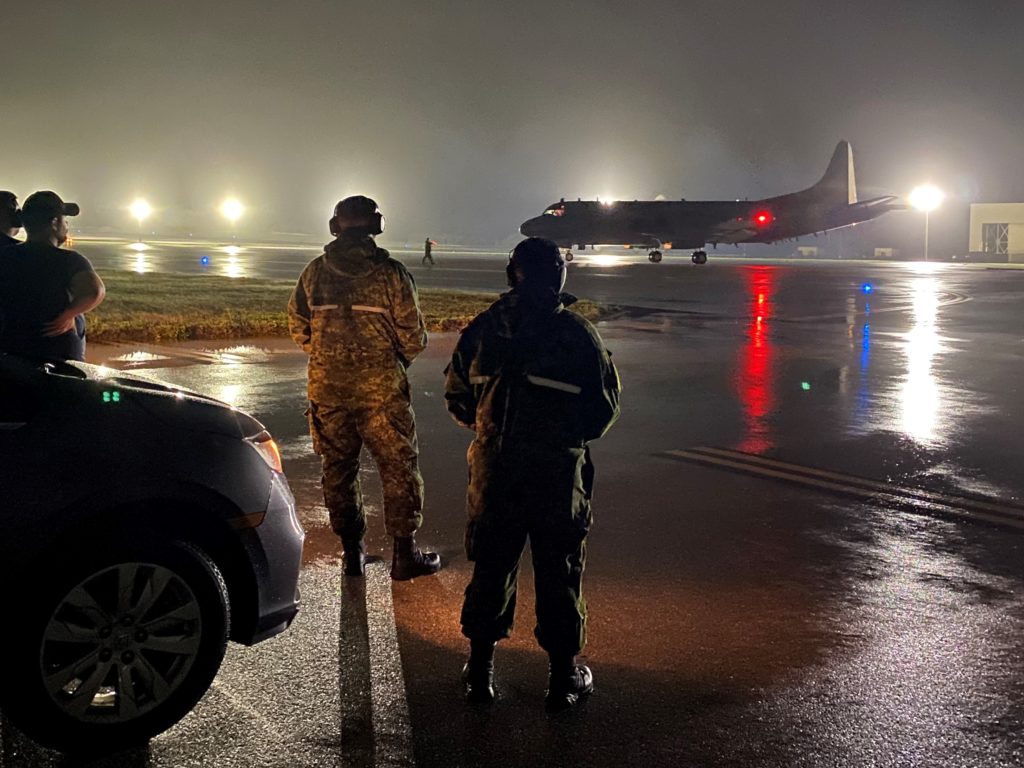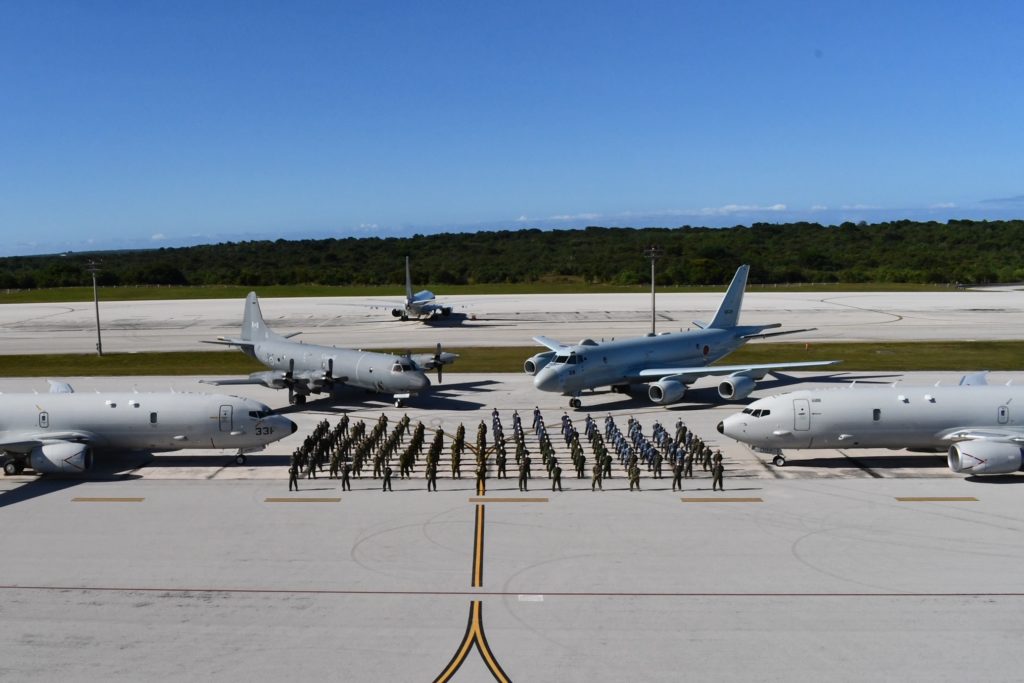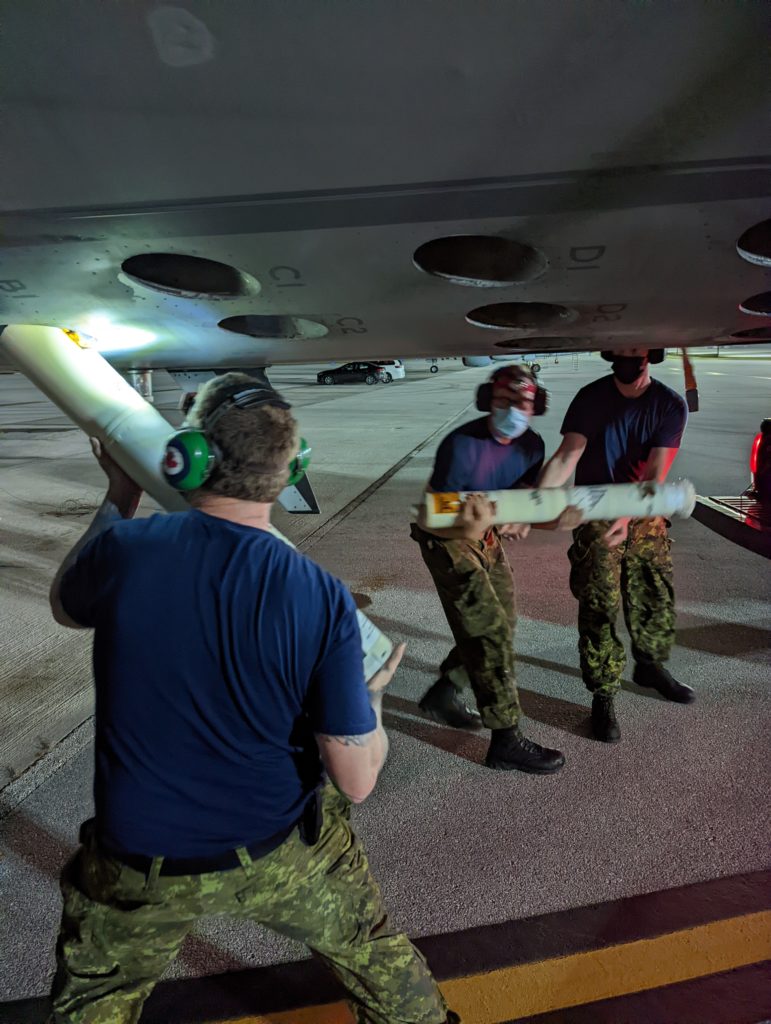Estimated reading time 13 minutes, 20 seconds.
For the second year in a row, a team from 407 Long Range Patrol Squadron at 19 Wing Comox, British Columbia, has shown itself to be a lethal submarine hunter.
Operating over a training range near the island of Guam in the Western Pacific, the CP-140 Aurora aircrew edged out teams from the United States Navy, Royal Australian Air Force (RAAF), Indian Navy, Japan Maritime Self-Defense Force (JMSDF), and Republic of Korea Navy (RSKN) in an anti-submarine warfare (ASW) exercise known as Sea Dragon.
The annual three-week event was hosted in January by the U.S. Navy Seventh Fleet at Andersen Air Force Base and provided a realistic test of submarine warfare tactics. It was also a rare opportunity for the Canadian team to share best practices and strengthen mutual understanding and cooperation with non-traditional Pacific nation allies.

“This part of the world is fairly new to us,” acknowledged Maj Len Kosciukiewicz, a CP-140 pilot. “Participants like India, South Korea, and Japan are countries we don’t normally get to exercise with so, to have them all operating from the same base [with the U.S. and Australia], that is unique.”
Sea Dragon included both classroom sessions and over 270 hours of in-flight training, detecting, tracking, and prosecuting simulated and live targets in a warfighting environment. The participants “eased” into the exercise against an expendable mobile ASW training target (EMATT) to develop familiarity with each country’s operating procedures, “breaking down the language barriers, and making sure everybody operates safely and conducts good handovers to maintain contact on the target for an extended period of time,” he explained.
The competition then kicked into high gear in the second phase against a more advanced simulated contact radiating noise for passive tracking and torpedo homing on a range able to calibrate and measure the accuracy of attacks. For the final event, participants actively and passively tracked and simulated attacks on a live U.S. Navy submarine, handing off to one another over several days. The range allowed for the calculation of the ballistics of each drop and participants were scored on their ability to classify targets and the speed and accuracy of their attacks.
Reclaiming the coveted Dragon’s Belt as the overall top performer was a point of pride for the Aurora crew and maintainers, who also won the Kraken award for the most consistent attacks. The CP-140 is a variant of the Lockheed Martin P-3 Orion, but recent upgrades to mission systems, radar, EO/IR, and other sensors, as well as acoustic detection capabilities, have kept the aircraft on par with the newer Boeing P-8A Poseidon operated by the American, Australian, and Indian teams.

As part of the Aurora Incremental Modernization Project, the CP-140 has undergone multiple systems enhancements, delivered in four comprehensive blocks. The final Block IV, to be validated later this spring, will add high-bandwidth beyond-line-of-sight satellite communication, Link 16 tactical data exchange network access, and a new self-defense system.
Block IV “will allow us to continue to operate with the other countries, the Americans in particular,” said Kosciukiewicz. “These kinds of exercises are extremely important to enable us to [remain] interoperable with these other countries.”
In addition to the RAAF and Indian P-8s and two U.S. Navy P-8s, the annual training exercise included a Japanese Kawasaki P-1 maritime patrol aircraft and two RSKN P-3CK Orion aircraft. While there were some initial technical communications and datalink exchange issues among the P-8s, P-3s and P-1s, there were no problems handing off targets between the aircraft.
“We operate a little bit differently being a turboprop airplane and the types of sonobuoys we use,” Kosciukiewicz explained of the Block III Aurora. “The P-8 tends towards higher altitude tracking. We continue to operate at very low levels, 200 to 300 feet [above the water]. There are advantages and disadvantages to both.”
The CP-140 does not have the air-to-air refueling ability of the Poseidon – a “nice capability to have,” he noted – but “has quite long endurance, long range” and can extend its on-station time by shutting one or two of its four engines.
407 Squadron trains regularly with the United States, Australia, and other Commonwealth partners such as the United Kingdom and New Zealand, but the Canadian long range patrol community is far more familiar with operations and exercise over the Atlantic Ocean. It only began supporting United Nations sanctions imposed against North Korea in 2018 as part of Operation Projection, now called Op Neon.
“It is fairly new for us to work with Koreans, the Japanese, and the Indians,” said Kosciukiewicz, who has spent much of his career on the squadron, between postings as an instructor with 404 Long Range Patrol and Training Squadron, on exchange in the United States on the E-3 Sentry airborne warning and control system (AWACS) aircraft, and with 415 Long Range Patrol Force Development Squadron.

But for a self-described “ASW geek,” the sea surrounding the Marianas Islands offers new “challenges from an oceanographic perspective.” The blue waters around the islands “drop off like a rock” offshore and, at its deepest, the Mariana Trench southwest of Guam descends to 11,034 meters (36,201 feet). “This is priceless terrain. We don’t see this elsewhere,” he said. “It is like a four-dimensional chess game down there.”
CHALLENGING MAINTENANCE
Most of 407 Squadron’s approximately 35 aircrew and maintainers were participating in Sea Dragon for the first time. But for a select few, including the crew commander, Capt Abigail Edwards, who conducted her check ride while contending for the Dragon Belt in 2021, it was an opportunity to defend a title.
Bragging rights aside, the exercise is more about relationship building with allies and providing crucial force generation training to qualify squadron members, Kosciukiewicz said. “The training we get is invaluable. We don’t get the opportunity to fly at live targets often. It is the best training possible for them; it is extremely important for their development, to progress in their trades. Just being able to operate in this part of the world is tremendous for us.”
Learning from the previous year, the squadron sent one augmented aircrew – to manage possible Covid-19 cases – and two full maintenance crews to ensure the Aurora was turned around and airborne throughout the intense competition. “Last year we went with one maintenance crew and had some maintenance issue that pushed the team to the brink,” said Kosciukiewicz. “We decided to go with two teams this year, but we didn’t have the same maintenance issues. The airplane performed remarkably well.”
Nonetheless, the extreme heat and humidity of Guam required some mitigating measures, from sunscreen and water to plenty of rest, to protect the health of the maintenance technicians on the overheated tarmac and keep the aircraft avionics equipment cool before takeoff, said Maj Ryan Wilson, who led the maintenance team.
“We [were] flying almost every day,” he noted. “If you try to utilize one [crew] for several days straight in this heat — about two to three hours before the plane launches and then two to three more when it returns – that heat can burn your people out pretty fast. With the second group, we were able to alternate and keep people well rested and make sure they were mission focused.”

With an 18-hour time difference between Guam and Comox, managing logistics also proved a challenge. The squadron airlifted a Pack Up Kit (PUK) of spare parts, a spare engine, and prop on a CC-177 Globemaster. Maintainers know the reliability of parts and can plan ahead, Wilson said, but if something goes wrong, “you are looking at five to seven days transport from Canada.”
With allies transitioning to P-8A fleets and only the South Korean navy flying a P-3 variant, there were fewer partners from whom to borrow or purchase parts. “The P-3 and P-8 are two totally different aircraft with very little in common for parts,” he said, but the six nations still found ways to assist where needed. “We have a very good working relationship with all of the countries, and we all do our best to set each other up for success when it comes to providing serviceable and airworthy aircraft for the missions.”
The added challenges are particularly valuable lessons for the squadron’s junior technicians, forcing them to “step out of their comfort zones” when resources are not readily at hand, Wilson said. “This helps build confidence to operate in the challenges of logistics and weather and such, and will pay great dividends down the road should they deploy to an operational setting.”
Both Kosciukiewicz and Wilson credited the entire Royal Canadian Air Force (RCAF) long range patrol community and industry partners for the CP-140’s performance on the exercise. “This really is an RCAF win, with everything that has been done to upgrade the Aurora,” said Wilson.
The Squadron was formed in England as No. 407 (General Reconnaissance) Squadron in May 1941 and earned its nickname, the Demons, for attacks on enemy shipping. Eighty years later, exercises like Sea Dragon allow “us to pay homage to our roots,” he added. “It is great for us to prove we are able to perform and live up to that earned name, Demons.”








